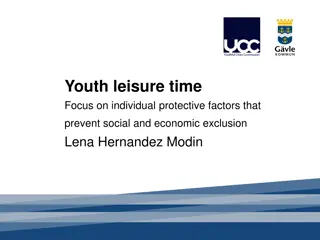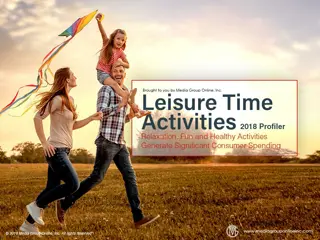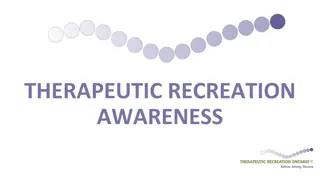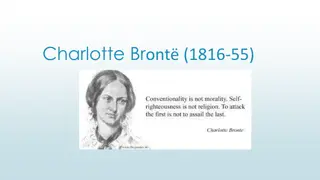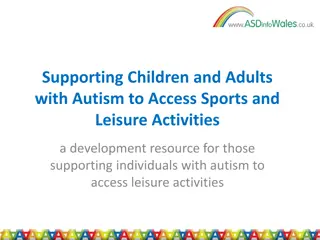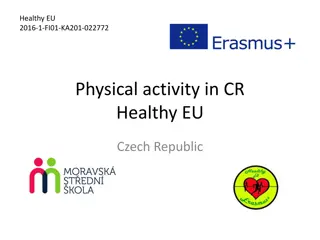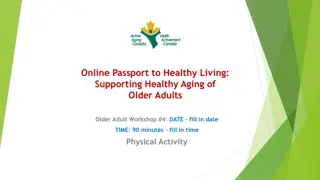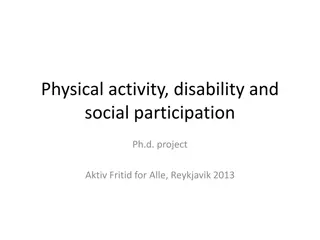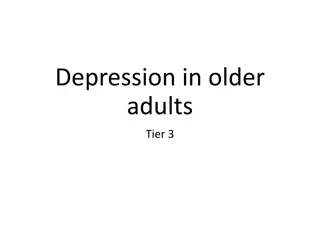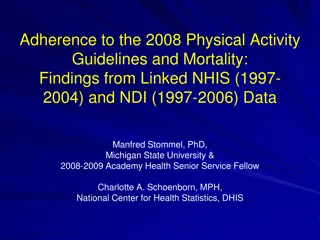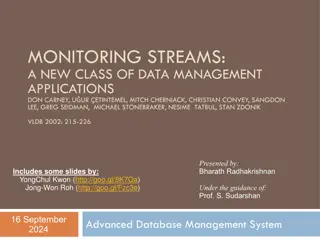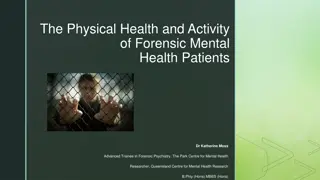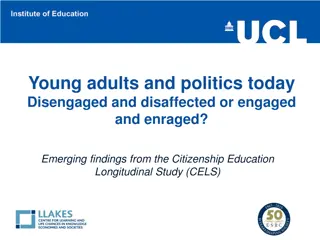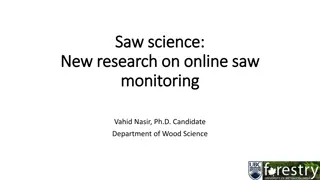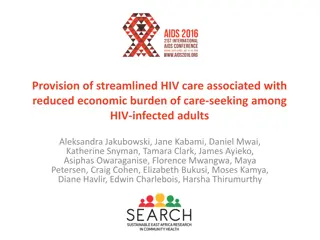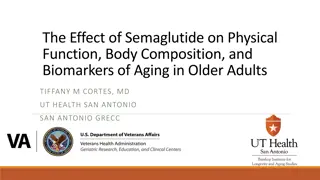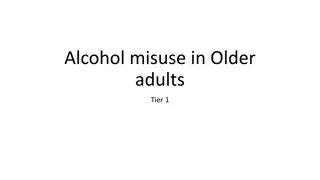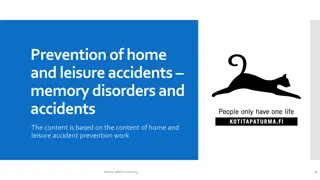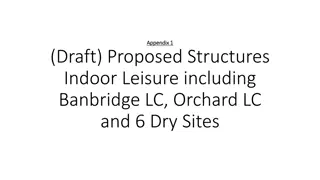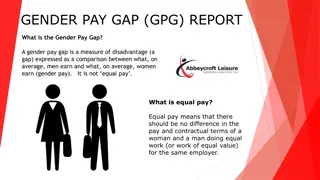Monitoring Leisure-Time Physical Activity Among U.S. Adults by Charlotte A. Schoenborn
This presentation by Charlotte A. Schoenborn discusses the monitoring of leisure-time physical activity among U.S. adults, highlighting the NHIS data collected periodically since 1975. The transition to the 2008 Physical Activity Guidelines, including new directions and definitions, is explored, as well as the influence on surveillance, prevalence estimates, socio-demographic variations, and trends. The changing criteria for being aerobically active under the Healthy People 2010 and 2008 Guidelines are also detailed.
Download Presentation

Please find below an Image/Link to download the presentation.
The content on the website is provided AS IS for your information and personal use only. It may not be sold, licensed, or shared on other websites without obtaining consent from the author. Download presentation by click this link. If you encounter any issues during the download, it is possible that the publisher has removed the file from their server.
E N D
Presentation Transcript
Monitoring Leisure-Time Physical Activity among U.S. Adults Charlotte A. Schoenborn Division of Health Interview Statistics National Center for Health Statistics Centers for Disease Control and Prevention The findings and conclusions in this presentation are those of the authors and do not necessarily represent the official position of the Centers for Disease Control and Prevention.
Co-authors Susan Carlson Janet Fulton Fleetwood Loustalot National Center for Chronic Disease Prevention and Health Promotion, CDC 2
NHIS Leisure-time Physical Activity Collected periodically since 1975 and annually since 1997. Monitors progress toward National Healthy People (HP) Objectives. LTPA indicators will change with move from HP 2010 to HP 2020. 3
New Directions New Physical Activity Guidelines issued in 2008 Based on comprehensive review of scientific evidence 4
NHIS AdultPhysical Activity Indicators Healthy People 2010 (2000-2009) 2008 PA Guidelines (2010 - forward) 5
What is new about the 2008 Physical Activity Guidelines ? Definition of aerobically active Additional guidelines: Highly active level Combined muscle-strengthening AND aerobic activity 6
Does the transition to the 2008 Guidelines influence surveillance? Prevalence estimates? Socio-demographic variations? Trends? 7
The Changing Definition of Aerobically Active for Adults Healthy People 2010 criteria 2008 Guidelines criteria Equivalent Combination Intensity Moderate Vigorous Moderate Vigorous Duration (min/day) Frequency (days/week) Volume (min/week) 30 20 5 3 150 75 150 8
Prevalence of being aerobically active: Healthy People 2010 versus 2008 Guidelines, NHIS, 2009 Healthy People 2010 criteria 2008 Guidelines criteria % 95% CI % 95% CI 34.9 34.0, 35.8 47.2 46.2, 48.2 Source: National Health Interview Survey, Sample Adult Component, 2009. Unpublished data. 9
Comparing Healthy People 2010 and 2008 Guidelines criteria for aerobic activity, by sex and age: NHIS 2009 100 100 Sex Age group Men Women 18-24 25-34 35-44 45-64 65+ 80 80 Age-adjusted prevalence Prevalence 60 60 40 40 20 20 0 0 Healthy People 2010 2008 Guidelines Healthy People 2010 2008 Guidelines 10
Comparing Healthy People 2010 and 2008 Guidelines criteria for aerobic activity, by race/ethnicity and education: NHIS 2009 100 Race/ethnicity 100 Education level White, non-Hispanic Black, non-Hispanic Asian, non-Hispanic Hispanic Less than HS graduate HS graduate Some college College graduate 80 80 Age-adjusted prevalence Age-adjusted prevalence 60 60 40 40 20 20 0 0 Healthy People 2010 2008 Guidelines Healthy People 2010 2008 Guidelines 11
Trends in aerobic activity 1998-2009: Healthy People 2010 versus 2008 Guidelines HP 2010 2008 Guidelines 100 80 Age-adjusted Prevalence 60 47.2 40.1 40 34.9 29.7 20 0 1998 1999 2000 2001 2002 2003 2004 2005 2006 2007 2008 2009 12 Source: CDC/NCHS: National Health Interview Survey
Highly Active Level Level new with 2008 Guidelines Aerobic physical activity for: > 300 min/week moderate-intensity > 150 min/week vigorous-intensity Equivalent combination 13
Prevalence of aerobic physical activity in four levels, NHIS 2009 100 80 Age-adjusted prevalence Active 60 40 32.7 31.2 20.3 20 15.8 0 Highly active Sufficiently active Insufficiently active Inactive Highly active (>300 min/wk moderate-intensity activity, >150 min/wk vigorous-intensity activity, or equivalent combination), sufficiently active (150-300 min/wk moderate-intensity activity, 75-150 min/wk vigorous-intensity activity, or equivalent combination), insufficiently active (some activity but not enough to meet active definition), and inactive (no activity of at least 10 min/time). 14
Percentage of adults who were highly active according to the 2008 Guidelines: NHIS 2009 100 80 Sex Race/ethnicity Education Age-Adjusted Prevalence 60 41.7 40 36.2 34.1 32.6 26.7 26.6 25.5 24.6 18.8 20 0 Men Women White Black Hispanic Less than HS HS Some college College graduate 15 graduate
Muscle-strengthening and aerobic activity HP 2010: Separate muscle-strengthening objective 2008 Guidelines: Combine muscle-strengthening with aerobic activity 16
Percentage of adults who met the muscle- strengthening and aerobic guideline, NHIS 2009 100 80 Age-adjusted prevalence Active 60 49.4 40 28.1 19 20 3.5 0 Met aerobic and muscle- strengthening guideline Met aerobic guideline only Met muscle- strengthening guideline only Met neither 17
Percentage of adults who met the full 2008 Guidelines (aerobic + strength) by selected characteristics, NHIS 2009 100 80 Race/ethnicity Education Sex Age-Adjusted prevalence 60 40 30.1 22.0 21.2 21.0 17.7 20 16.2 12.6 11.5 7.3 0 Men Women White Black Hispanic Less than HS HS Some college College graduate 18 graduate
Trends in meeting 2008 Aerobic PA Guideline among U.S. adults, by sex: 2007-2009 60 2007 2008 2009 50 Age-Adjusted Prevalence 40 30 20 10 0 Men Women 19 Source: CDC/NCHS: National Health Interview Survey,
Trends in meeting 2008 Aerobic PA Guideline among U.S. adults, by age: 2007-2009 2007 2008 2009 60 50 Percentage of adults 40 30 20 10 0 18-24 25-44 45-64 65+ 20 Source: CDC/NCHS: National Health Interview Survey,
Trends in meeting 2008 Aerobic PA Guideline among U.S. adults, by race/ethnicity: 2007-2009 2007 2008 2009 60 50 Age-adjusted Prevalence 40 30 20 10 0 White, NH Black, NH Asian, NH Hispanic 21 Source: CDC/NCHS: National Health Interview Survey,
Trends in meeting PA 2008 Aerobic PA Guideline among U.S. adults, by education: 2007-2009 2007 2008 2009 60 50 Age-adjusted Prevalence 40 30 20 10 0 < 12 years HS graduate Some College College graduate Source: CDC/NCHS: National Health Interview Survey, 22
Conclusions Compared with HP 2010 criteria, prevalence estimates shifted to upward by more than 10 percentage points when 2008 Guidelines were applied. Disparities and trends over time were similar regardless of the LTPA criteria. Leisure-time physical activity prevalence at recommended levels has increased modestly in recent years. 23
For Further Information NHIS Physical Activity Information Website: http://www.cdc.gov/nchs/nhis/physical_activity.htm NHIS listserve: nhislist@cdc.gov For questions about this presentation, feel free to contact me at: CSchoenborn@cdc.gov Thank you! 24


